Hydroxybenzoate Salts Of Metanicotine Compounds
a technology of nicotinic compounds and hydroxybenzoate salts, which is applied in the direction of heterocyclic compound active ingredients, biocide, drug compositions, etc., can solve the problems of difficult removal of minor reaction products and elicit various undesirable pharmacological effects, so as to increase the number of nicotinic cholinergic receptors of the brain, prevent and suppress symptoms, and modulate neurotransmitter secretion
- Summary
- Abstract
- Description
- Claims
- Application Information
AI Technical Summary
Benefits of technology
Problems solved by technology
Method used
Image
Examples
example 1
Synthesis of (2S)-(4E)-N-methyl-5-(5-isopropoxy-3-pyridinyl)-4-penten-2-amine p-hydroxybenzoate
(2S)-(4E)-N-methyl-5-(5-isopropoxy-3-pyridinyl)-4-penten-2-amine p-hydroxybenzoate
[0110]p-Hydroxybenzoic acid (2.62 g, 19.0 mmol) was added in portions to a stirred solution (2S)-(4E)-N-methyl-5-(5-isopropoxy-3-pyridinyl)-4-penten-2-amine (4.79 g of 93% pure, 19.0 mmol) in isopropyl acetate (50 mL). During the addition, crystallization of salt was evident. After complete addition of the p-hydroxybenzoic acid, the suspension was heated near its boiling point as isopropanol was slowly added. After 15 mL of isopropanol had been added, complete dissolution was obtained. Cooling of the solution to ambient temperature (overnight) resulted in deposition of a crystalline mass, which was collected by suction filtration and air dried (4.03 g). A second crop (0.82 g) was isolated from the concentrated filtrate, by addition of acetone. The two crops of crystals were combined and recrystallized from ac...
example 2
Synthesis of (2S)-(4E)-N-methyl-5-(5-isopropoxy-3-pyridinyl)-4-penten-2-amine (via the Heck reaction with (S)-N-Methyl-N-(tert-butoxycarbonyl)-4-penten-2-amine) and the use of the p-hydroxybenzoate salt to facilitate isolation and purification of (2S)-(4E)-N-methyl-5-(5-isopropoxy-3-pyridinyl)-4-penten-2-amine:
3-Bromo-5-isopropoxypyridine
[0111]A 72 L reactor was charged successively with sodium tert-pentoxide (2.2 kg, 20 mol) and 1-methyl-2-pyrrolidinone (17.6 L). This mixture was stirred for 1 h, and then 2-propanol (12 L) was added over a period of 2 h. 3,5-Dibromopyridine (3.0 kg, 13 mol) was then added to the reactor, and the mixture was heated at 75° C. for 12 h under a nitrogen atmosphere. The mixture was then cooled, diluted with toluene (15 L), and washed with water (30 L). The aqueous phase was extracted with toluene (15 L), and the combined toluene phases were washed with water (15 L) and concentrated under reduced pressure, to give 2.5 kg of dark oil. This was combined an...
example 3
Synthesis of (2S)-(4E)-N-methyl-5-(5-methoxy-3-pyridinyl)-4-penten-2-amine 2,5-dihydroxybenzoate (gentisate)
(2S)-(4E)-N-Methyl-5-(5-methoxy-3-pyridinyl)-4-penten-2-amine 2,5-dihydroxybenzoate
[0115]A hot solution of 2,5-dihydroxybenzoic acid (gentisic acid) (0.582 g, 3.78 mmol) in absolute ethanol (1 mL) was added to a warm solution of (2S)-(4E)-N-methyl-5-(5-methoxy-3-pyridinyl)-4-penten-2-amine (1.00 g, 4.85 mmol, 86.7% E isomer by GC-FID) in absolute ethanol (1 mL), using additional ethanol (2 mL) in the transfer. The resulting mixture was concentrated via rotary evaporation, leaving 1.5 mL of ethanol in the solution. With stirring and heating to near reflux, crystallization occurred. The resulting hot mixture was treated drop-wise with ethyl acetate (5.5 mL). After cooling to room temperature, the mixture was further cooled at 5° C. for 48 h. The resulting solids were filtered, washed with ethyl acetate (2×5 mL) and dried at 50° C. to give 1.24 g (91%) of an off-white powder (98....
PUM
 Login to View More
Login to View More Abstract
Description
Claims
Application Information
 Login to View More
Login to View More - R&D
- Intellectual Property
- Life Sciences
- Materials
- Tech Scout
- Unparalleled Data Quality
- Higher Quality Content
- 60% Fewer Hallucinations
Browse by: Latest US Patents, China's latest patents, Technical Efficacy Thesaurus, Application Domain, Technology Topic, Popular Technical Reports.
© 2025 PatSnap. All rights reserved.Legal|Privacy policy|Modern Slavery Act Transparency Statement|Sitemap|About US| Contact US: help@patsnap.com



